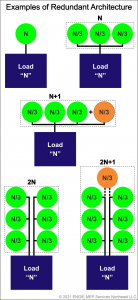Resiliency and Redundancy for Facilities
Posted on June 1st, 2021

Electrical resiliency is a topic of increasing interest for property owners and facility managers due to the devastating failures of the electrical grid over the past few years. Recent problems in Texas, California and Europe suggest that electrical disruptions are increasingly attributable to lapses in judgement in addition to the nature-caused destruction of infra
structure. For facilities, electrical “resiliency” means adjusting to the decline in electric supply reliability which may necessitate the use of backup, standby or redundant equipment or systems.
Backup and Standby
The terms “backup”, “standby” and “redundant” are sometimes used interchangeably, but their practical meanings suggest there is considerable difference:
- “Backup” refers to a substitute,
- “Standby”, means held near at hand and ready for use, and
- “Redundant” means exceeding what is necessary or normal.
The difference between backup and standby relates primarily to location and/or timing.
For example, a backup pump is most likely stored in its original packaging perhaps in a central parts storage location. It generally takes some tools, time and shutting down a process to replace a failed pump with a backup pump. Alternatively, a standby pump would likely be installed in parallel with an operating pump but be valved off and de-energized. The standby pump can then be put into service in minutes rather than the hours it might take to install a backup.
What is often called a “backup generator” is more accurately a standby generator. While it is true that the generator “backs up” the electrical supply, it is installed, operable and standing by for operation within a matter of seconds.
Redundant
The concepts of backup and standby imply not only a one-for-one relationship between the original equipment and the new piece but an equivalence of size or capacity. “Redundant”, on the other hand, suggests additional capacity capable of exceeding the necessary function. For example, facilities often have redundant water pumps, water heaters or boilers so that operations automatically continue as normal if one component fails. The number and capacity of pieces and system configuration is dictated by the criticality of the operation.
Major considerations for optimum redundancy include capacity, efficiency and cost.
By way of example, imagine a facility wants to improve its electrical resiliency by installing 500 kW of generation supplied by microturbines. The microturbines are available in 25 kW, 50 kW, 100 kW, 250 kW and 500 kW sizes. In redundancy architecture terminology, the 500 kW load would be called “N” which can be achieved by any combination of microturbines equaling 500 kW (e.g. five 100 kW units or two 250 kW).
The easiest and least expensive solution would be to use a single 500 kW microturbine. However, providing “N” in a single unit is the same as having no redundancy. That leaves a vulnerability if the one unit is out of service for maintenance or some other reason.
A very common redundancy strategy is utilizing “N+1” which means having one more than the minimum number of units needed to meet “N”. That might be six 100 kW or three 250 kW microturbines, in the example. This, however, highlights the need to consider capacity, efficiency and cost.
Six 100s and the three 250s operated simultaneously deliver 600 kW and 750 kW, respectively, and easily cover the 500kW capacity needed even if one unit is out of service. In terms of efficiency, if all units run simultaneously, the six 100s and the three 250s would operate at 83% and 67% of full load, respectively. Since maximum efficiency for microturbines occurs close to full load, the six 100s may have an efficiency and total energy use advantage. Cost-wise, three 250s likely benefit from economy of scale and have lower costs than the six 100s for equipment, installation and maintenance.
There are numerous other redundancy schemes including N+2, 2N, 2(N+1) to meet various resiliency requirements. It should be clear at this point that the purpose of redundancy is to prevent the failure of one or more components or resources (e.g. the electrical grid) from disturbing or interrupting critical processes.
Resiliency & Redundancy
Moving beyond the traditional architecture, redundancy can be achieved by an alternative rather than simply more units. In the example above, the microturbines increase resiliency in multiple ways: they are an alternative to receiving electricity from the grid and are also a redundant source of electricity themselves.
When it comes to redundancy and resiliency, the natural gas network is far more reliable than the electrical network. The production of natural gas is widely distributed through many thousands of wells, nearly all of the natural gas infrastructure is underground and much of the storage and distribution system is self-powered by natural gas. A 2013 study for the U.S. Department of Defense on energy infrastructure security concluded, “The natural gas system is generally robust to two-week to three-month outages in the electricity supply, depending on the time of year”.
Ultimately, redundancy is a means to increase resiliency which is the defense against poor or declining reliability.
Equans MEP Services
The professionals at Equans MEP Services can help you assess the vulnerability and resiliency of your facility’s electrical supply, HVAC and mechanical systems. Furthermore, they can show you ways that increasing resiliency might actually reduce energy consumption and save you money. Call your local MEP Services representative today to start discussing your facility’s resiliency.
